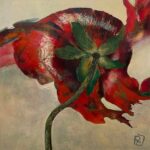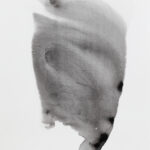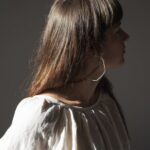JEAN-FRANCOIS PEREÑA – “An artist is an inspired craftsman” ~Walter Gropius

This blog posts for the month of October and the following one in December will be dedicated to the work of two top-ranking artists: first to Jean François Pereña who is the maker of extraordinary jewels and then to his wife Mireille Moser, a ceramist.
ROCHEBAUDIN
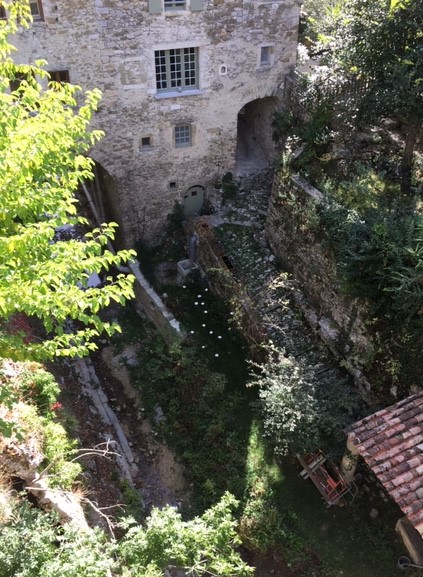 20 km to the east of Montélimar the D 328 road will take you to the picturesque little village of Rochebaudin (Pop. 120) that goes back in time to the 12th century and is embedded in a gorge, both sides being linked by an old stone bridge. After having crossed it coming from the west, the road passes through a hollowed-out arc in the rock before going further up into the mountain. The name Rochebaudin is a reference to the site as “roche” means “rock” in French and “baudin” is derived from the old French word for crossbar. When you lean over the parapet of the bridge and look down on the jumble of roofs, miniature gardens and terraces below it is hard not to feel a touch of claustrophobia imagining what it must be like to live in a space so closely cupped in between two steep hillsides. But the inhabitants don’t seem to mind! As so often in the Drôme the combination of a beautiful natural site with the long-past traces of human presence contribute greatly to the charm of Rochebaudin. This did not pass unnoticed to Jean-François and Mireille who decided, 33 years ago, to leave Switzerland their previous home, where they had been active as artists, and purchase an old inn where they now live.
20 km to the east of Montélimar the D 328 road will take you to the picturesque little village of Rochebaudin (Pop. 120) that goes back in time to the 12th century and is embedded in a gorge, both sides being linked by an old stone bridge. After having crossed it coming from the west, the road passes through a hollowed-out arc in the rock before going further up into the mountain. The name Rochebaudin is a reference to the site as “roche” means “rock” in French and “baudin” is derived from the old French word for crossbar. When you lean over the parapet of the bridge and look down on the jumble of roofs, miniature gardens and terraces below it is hard not to feel a touch of claustrophobia imagining what it must be like to live in a space so closely cupped in between two steep hillsides. But the inhabitants don’t seem to mind! As so often in the Drôme the combination of a beautiful natural site with the long-past traces of human presence contribute greatly to the charm of Rochebaudin. This did not pass unnoticed to Jean-François and Mireille who decided, 33 years ago, to leave Switzerland their previous home, where they had been active as artists, and purchase an old inn where they now live.
JEAN-FRANCOIS PEREÑA
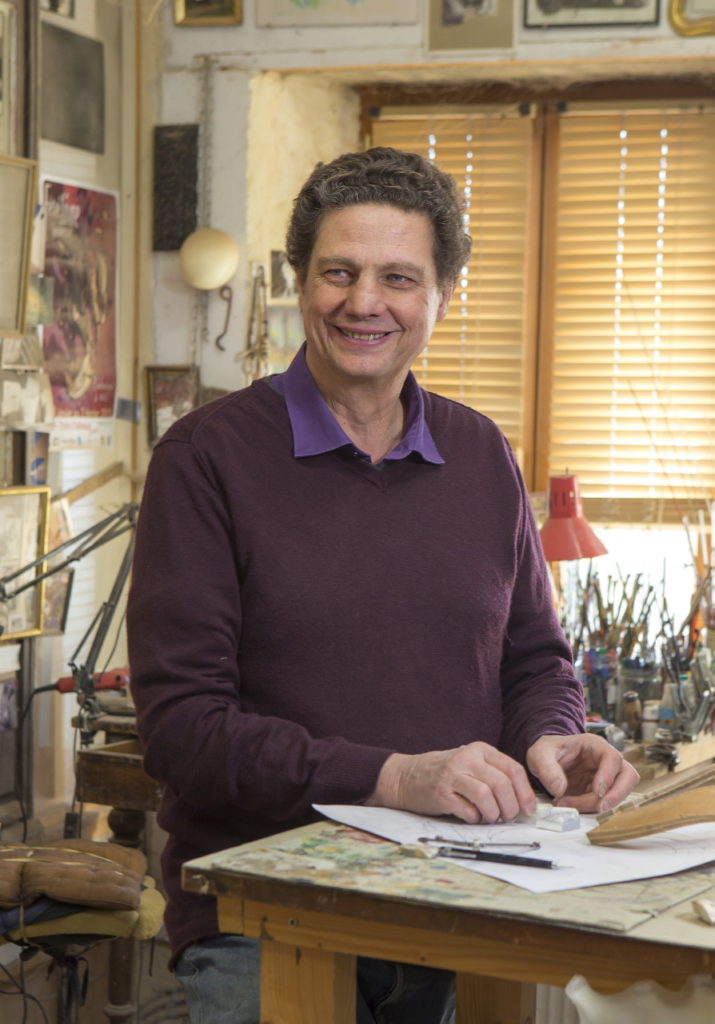 The first time I met Jean-François Pereña I had this strange feeling that something was missing. He is a big and friendly man with the bearing of a matador, be it a matador with a slightly rounded waistline. The fact that he is a Spaniard could explain the bullfighter’s poise. And then it dawned on me that the missing piece must be an ample pitch black “Capa” like the one he often dons and drapes around his shoulders, upgrading him to the status of Spanish grandee. I recently asked him whether his Spanish background had any effect on the art he creates. “Not really” he replied. He comes from a very mixed ancestry which would render it difficult to trace some form of genetic influence. On the other hand it is quite possible that his work is influenced by the preoccupation he has had ever since his youth with life and especially death that so deeply affects Spanish culture. Perhaps again the stark landscapes of his homeland, the harshness of the climate, the sharp contrasts between light and shadow could account for why his creations are characterised by combinations of opposites such as mineral and animal matter. However, Jean- François does not believe that these considerations are conclusive nor that his art can be qualified as Spanish.
The first time I met Jean-François Pereña I had this strange feeling that something was missing. He is a big and friendly man with the bearing of a matador, be it a matador with a slightly rounded waistline. The fact that he is a Spaniard could explain the bullfighter’s poise. And then it dawned on me that the missing piece must be an ample pitch black “Capa” like the one he often dons and drapes around his shoulders, upgrading him to the status of Spanish grandee. I recently asked him whether his Spanish background had any effect on the art he creates. “Not really” he replied. He comes from a very mixed ancestry which would render it difficult to trace some form of genetic influence. On the other hand it is quite possible that his work is influenced by the preoccupation he has had ever since his youth with life and especially death that so deeply affects Spanish culture. Perhaps again the stark landscapes of his homeland, the harshness of the climate, the sharp contrasts between light and shadow could account for why his creations are characterised by combinations of opposites such as mineral and animal matter. However, Jean- François does not believe that these considerations are conclusive nor that his art can be qualified as Spanish.
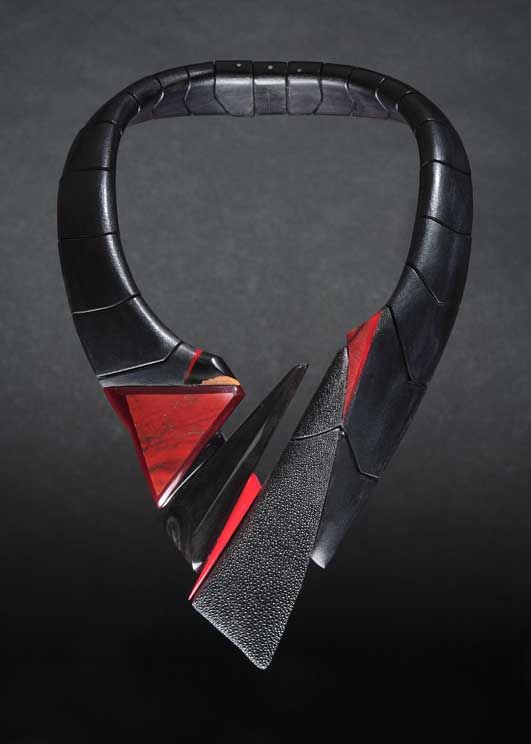 Although Jean-François creates jewels, he is not a jeweller in the generally accepted sense of the term and calls himself a “jewelery creator” Those who expect the conventional maker of wedding rings, bracelets and necklaces set with diamonds and other precious stones are in for a big surprise. The sheer size of his jewels, their intricate forms and the materials they are made of make them resemble sculptures, not the ones mounted on a pedestal but made to be worn as striking eye-catchers that enhance the bearing of the person who wears them. If a woman happens to show interest in his creations, Jean-François will immediately select one of the larger pieces and with a flourish place it around her arm or neck enquiring how it feels. Mostly, the answer will be that she hardly notices their weight and that they have the softness of velvet. One woman who is a great collector of his work once said, “Pereña ’s pieces of jewellery have a strong presence and they require a certain décor to be worn properly. I never choose my jewellery according to what I am wearing. I decide which one suits my mood and the choice of clothes immediately becomes obvious…”
Although Jean-François creates jewels, he is not a jeweller in the generally accepted sense of the term and calls himself a “jewelery creator” Those who expect the conventional maker of wedding rings, bracelets and necklaces set with diamonds and other precious stones are in for a big surprise. The sheer size of his jewels, their intricate forms and the materials they are made of make them resemble sculptures, not the ones mounted on a pedestal but made to be worn as striking eye-catchers that enhance the bearing of the person who wears them. If a woman happens to show interest in his creations, Jean-François will immediately select one of the larger pieces and with a flourish place it around her arm or neck enquiring how it feels. Mostly, the answer will be that she hardly notices their weight and that they have the softness of velvet. One woman who is a great collector of his work once said, “Pereña ’s pieces of jewellery have a strong presence and they require a certain décor to be worn properly. I never choose my jewellery according to what I am wearing. I decide which one suits my mood and the choice of clothes immediately becomes obvious…”
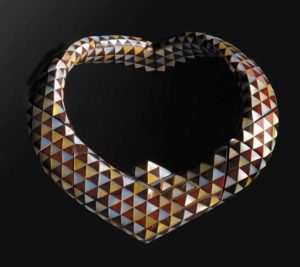 Through the ages woman’s beauty, elegance and the erotic appeal of her nakedness have been the subject of thousands upon thousands of paintings and sculptures. Jean-François will also be the first to tell you that “The aura of a woman is my constant source of inspiration” and his words are spoken with fervour and the Iberian intonation that has lingered notwithstanding the many years he has spent away from his homeland. But for him it is the way a woman moves, the movement of woman when she walks or sits down, when she combs her hair and even the poise of an athlete before she lunges forward!
Through the ages woman’s beauty, elegance and the erotic appeal of her nakedness have been the subject of thousands upon thousands of paintings and sculptures. Jean-François will also be the first to tell you that “The aura of a woman is my constant source of inspiration” and his words are spoken with fervour and the Iberian intonation that has lingered notwithstanding the many years he has spent away from his homeland. But for him it is the way a woman moves, the movement of woman when she walks or sits down, when she combs her hair and even the poise of an athlete before she lunges forward!
I wanted to know why Jean-François had chosen to make jewels.
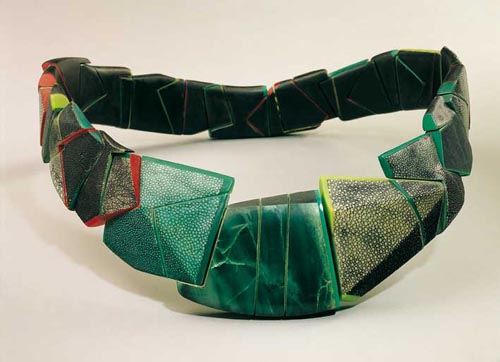 “It all began at the Geneva flea market where I happened to come across a pile of incomplete pairs of shoes that had belonged to the spouse of the famous King Farouk of Egypt. Each shoe was more extraordinary than the other but one of them in particular triggered my imagination. When it had been made and put together the leathers had undergone various treatments for different purposes. The piece of leather used for the high heel had a pyramidal form, the shoe itself looked like an open hand resting on the heel and its leather that was as fine and soft as suede used for gloves fitted every toe separately, like a second skin; the metal structured arch was wrapped in yet another kind of leather. These combinations and everything you can do with leather fascinate me. It can be used as a sheath, it can be sculpted.” Jean-François paused and reflected for a moment before adding “It also bears the weight of a woman while she moves; Just imagine!”
“It all began at the Geneva flea market where I happened to come across a pile of incomplete pairs of shoes that had belonged to the spouse of the famous King Farouk of Egypt. Each shoe was more extraordinary than the other but one of them in particular triggered my imagination. When it had been made and put together the leathers had undergone various treatments for different purposes. The piece of leather used for the high heel had a pyramidal form, the shoe itself looked like an open hand resting on the heel and its leather that was as fine and soft as suede used for gloves fitted every toe separately, like a second skin; the metal structured arch was wrapped in yet another kind of leather. These combinations and everything you can do with leather fascinate me. It can be used as a sheath, it can be sculpted.” Jean-François paused and reflected for a moment before adding “It also bears the weight of a woman while she moves; Just imagine!”
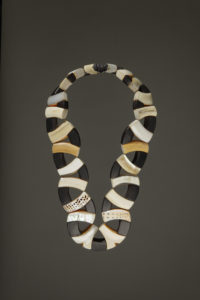
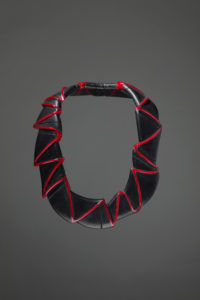
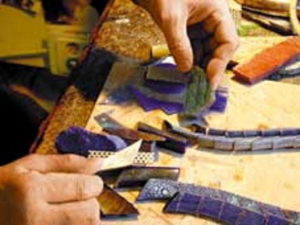 The first time we met, Jean-François who is a courteous host, invited me to follow him back into his workshop. For such a large figure of a man the space is quite narrow, a cocoon stacked with the most heterogeneous collection of mineral, metal and animal materials. Their sheer quantity is stunning. His craft as jewellery creator consists of combining them and putting them together with unparalleled skill. Stones and bones, tanned and dried skins of every imaginable mammal, reptile, fish and bird stored in labelled boxes stacked ceiling high against the walls. They give the studio the aspect of an old-fashioned shoemaker’s shop. A random sample of what they contain ranges from pieces of acacia, mahogany, coconut palm, sequoia, palm tusk, cork, mango skin, alabaster, lapis-lazuli, opal, marble, emu eggshell, sperm whale and shark teeth, cow horns, anteater stomach leather, iguana skins, gold and zinc, Bakelite and Plexiglas….AND LOTS MORE.
The first time we met, Jean-François who is a courteous host, invited me to follow him back into his workshop. For such a large figure of a man the space is quite narrow, a cocoon stacked with the most heterogeneous collection of mineral, metal and animal materials. Their sheer quantity is stunning. His craft as jewellery creator consists of combining them and putting them together with unparalleled skill. Stones and bones, tanned and dried skins of every imaginable mammal, reptile, fish and bird stored in labelled boxes stacked ceiling high against the walls. They give the studio the aspect of an old-fashioned shoemaker’s shop. A random sample of what they contain ranges from pieces of acacia, mahogany, coconut palm, sequoia, palm tusk, cork, mango skin, alabaster, lapis-lazuli, opal, marble, emu eggshell, sperm whale and shark teeth, cow horns, anteater stomach leather, iguana skins, gold and zinc, Bakelite and Plexiglas….AND LOTS MORE.
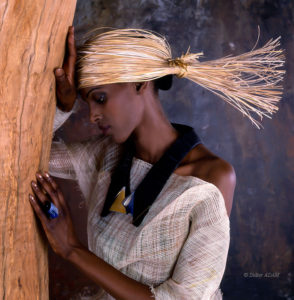 Most artists work with a limited range of materials. Sculptors carve stone and marble, weld steel and iron, cast their works in bronze and use fibreglass, painters work in oils, watercolour, pastels and little else. The range of materials with which Jean-François makes his creations is limitless. This superabundant collection, he says, hardly suffices to express the whole gamut of his emotions and longings. His reply when I questioned him illustrates to a certain degree how an awareness of the composite nature of ordinary things can evolve and become a source of creativity in the hands of an artist. As a young boy Jean-François suddenly realised something we don’t normally think about – and why should we? – that the hairs on his head and the hairs of his eyebrows, his eyelashes and the hairs on his arms were not the same. This also applied to the skin of his head, the skin of his lips, tongue, etc. The more he thought about it the more he became conscious that seemingly incompatible elements in nature could be combined to become one integrated and harmonious whole. As a consequence, one of his necklaces can be made up of twenty and often many more components: shellfish, antlers, horse tooth, lapis-lazuli, leather, white coral, alabaster, etc., etc.
Most artists work with a limited range of materials. Sculptors carve stone and marble, weld steel and iron, cast their works in bronze and use fibreglass, painters work in oils, watercolour, pastels and little else. The range of materials with which Jean-François makes his creations is limitless. This superabundant collection, he says, hardly suffices to express the whole gamut of his emotions and longings. His reply when I questioned him illustrates to a certain degree how an awareness of the composite nature of ordinary things can evolve and become a source of creativity in the hands of an artist. As a young boy Jean-François suddenly realised something we don’t normally think about – and why should we? – that the hairs on his head and the hairs of his eyebrows, his eyelashes and the hairs on his arms were not the same. This also applied to the skin of his head, the skin of his lips, tongue, etc. The more he thought about it the more he became conscious that seemingly incompatible elements in nature could be combined to become one integrated and harmonious whole. As a consequence, one of his necklaces can be made up of twenty and often many more components: shellfish, antlers, horse tooth, lapis-lazuli, leather, white coral, alabaster, etc., etc.
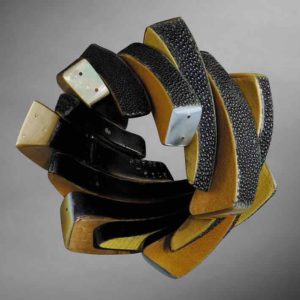
The colours, the compositions, the sheer complexity of Jean-François creations are enough to cause the admiration of the most demanding painter and sculptor. To this must be added that besides being an artist, he is also an incredibly talented craftsman in being able to assemble such a diversity of materials and turning them into homogeneous pieces of art. It is not surprising that collectors are keen to acquire his creations, nor that the Musée d’Art et d’Histoire in Geneva owns more than 80 of them. Today, with more than 2000 pieces of jewellery to his name and an impressive list of exhibitions in France and abroad Jean-François’s fascination for jewellery persists. At every moment of the day and sometimes in his dreams he creates objects. A light fall, the glint of a stone, the whispering of the wind, the sway of a woman’s hips can trigger the need to combine materials and forms. He will tell you that many of these impulses reach far back into childhood, when the patter of rain on a rooftop or the colour of a dress, little nothings perceived in a flash, used to affect him deeply.
Summing up and speaking for himself, Jean-François will tell you that assembling materials in multifarious combinations, has become his one and only way of creating order out of a “wonderful chaos.”
Posted in: Art
